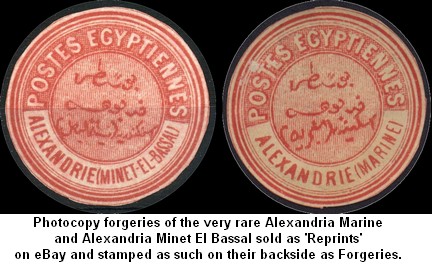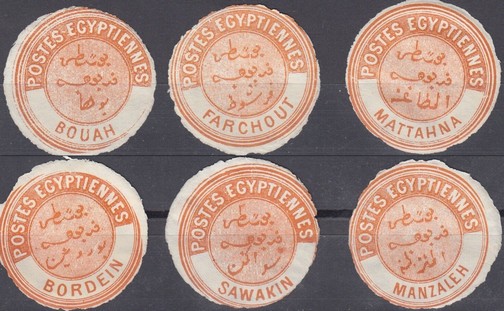Interpostal Seal Forgeries
Photocopies:
The Interpostal Seals of Egypt are not perforated and are very rarely watermarked, as such are easy to forge by modern photo-copying techniques. Several dealers offer forged, or reproduced, Interpostal Seals which are stamped ‘Forgery or Faux’ on the backside. However, a few unmarked forgeries continue to surface now and then and are mostly color photocopies.
Printing paper produced after the 1950’s contains fluorescent brighteners which are added during the manufacturing process. These fluoresce under long wave UV light. Interpostal Seals, printed on paper manufactured in the 19th century, do not contain any florescent material and will not appear bright if placed underneath a Long Wave ultraviolet light in surrounding darkness. An ultra-violet UV detector, often marketed for checking banknotes can be useful for this purpose. Below are two examples of very rare Interpostal Seals sold on e-Bay as ‘reprints’.

Forged Die-cut and Scissor-cut Edges of Interpostal Seals:
Genuine Interpostal Seals have smooth rounded edges punched through by a die-press. Most Interpostal Seal forgeries are uneven around the edges, the result of using crude man-made die-cutters which rip around the edges creating perforation-like overhangs rather than the smooth round circle. Forged, scissor-cut Interpostal Seals can be identified by close examination of the out-of-roundness scissor marks around the edges. In the above two ‘reprints’ although finely cut, careful examination shows where scissor marks were used to round the edges.
Hundreds of forgeries of types III and VIII-a were sold in Egypt in the early 1980’s, as genuine, see example in the picture below. The forger’s attempt to reproduce the vermilion color of the genuine seal resulted in a paler pinkish color, and used a crude circular cutter resulting in uneven edges. Several dealers sell this forgery on e-Bay and other philatelic sites as genuine.

In his April 1989 publication ‘Egyptian Topics‘ Peter Feltus wrote about the above forgery:
“Peter Feltus advises that someone has printed up a batch of forgeries of Types III and VIIIA Egyptian Interpostal seals. Peter has not reported any fakes of the “GEDDA” seals yet, but considering the prices commanded by these, prospective purchasers should be careful.”
Forgery of Interpostal Seal Colors by Dyes:
Other forgery techniques involve the use of dyes to alter the paper colors of genuine Interpostal Seals to produce a desired ‘fake’ color. The Kehr catalogue lists several color varieties, of types I, II, III, IV and V, some are very rare or never seen. In fact, a recurring criticism of the Kehr Catalogue is that several of Kehr’s listings are of colors never been seen by collectors. In his preface to the 1962 edition of the Kehr Catalogue, he lists all the collections he has reviewed to compile his Catalogue including those of Egypt’s royal family and other collectors containing what he believed to be rare ‘proofs’ of rare colors. Between Kehr’s first Catalogue edition of 1952, his revised edition of 1962 and subsequently his final 1984 edition, Kehr reported that he had examined more than half a million Interpostal Seals. Yet, there were colors he had not seen but were reported by the earlier Philatelist O. May in O. May’s catalogue of Interpostal Seals issued in 1914. These, which he had not personally seen, he attached an Asterix (*) against their catalogue number. Because of the rarity of those Interpostal Seals, listed but never, or seldom seen, some attempts of forgery were reported whereby an genuine seal is immersed in a dye to alter its color. However, this technique results in changing the paper color as well as the ink used to print the design and lettering of the original Interpostal Seal, which is black in most cases. Care should be taken in examining the paper as well as the ink colors against the Kehr listing to ascertain that, what appears to be a rare color is, in fact genuine.
The so-called Jaffa Forgery:
The literature contains articles about attempted forgery of the Type IV-a Jaffa Interpostal Seal in 1950’s. The first article was written by Ernst Kehr and widely read. Later, however, J. H. Posner wrote a counter-article in the BAPIP Bulletin arguing that these so-called forgery Jaffa Seals are in fact genuine. This argument still holds to that day.
Computer forged CDS’s On Interpostal Seals:
Used Interpostal seals with legible postmarks such as circular date stamps, showing the date and name of the post office are rare and demand a much higher premium than mint, or unused ones. There are several Interpostal Seals which are recorded as never been seen used. The quarterly issue of the Egypt Study Circle, June 2015, reported dangerous examples of forged postmarks, made by computer, on Interpostal Seals, so perfect that the author was not able to tell the difference and reported the forger’s ability to lift a postmark from a cover or stamp and reproduce it on another cover, Interpostal Seal, or stamp so perfectly as to be indistinguishable.